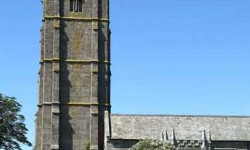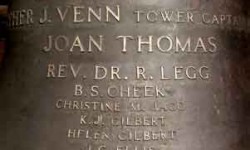
Bell epoch
From the St Buryan church in Cornwall, England, an abundance of sounds can be heard. The church is today the home of one of the world’s heaviest peal of six church bells. But the history of St Buryan’s church bells is long and marked by periods of silence.
The tower itself was completed in 1501, following 21 years of construction. The builders used local Lamorna granite. Some of the stones weigh more than two tonnes and give the tower its massive strength. Indeed, a 1991 survey showed that even with four bells swinging in the same direction, the 90-foot (27-metre) tower moved only 0.005 inches (0.13 millimetres).
The No. 4 bell is the oldest, dating back to 1638 when West Country founder R Pennington was given an order to cast eight bells. However, a church bell inventory in the late 19th century stated that only three bells were present, dated 1638, 1681 and 1738, thus suggesting that the work was never completed and also that at least two restorations had occurred during the intervening years.
In 1901, Warner’s bell foundry recast two of the old bells and supplemented them with a new tenor, at the same time also retuning the old treble bell. The improved peal was then hung in a new heavy-duty steel frame and dedicated on 31 July, 1901. A band of five men from St Mary’s, Penzance, rang a Bob Minimus composition, but after that the bells, as a full circle, fell into disuse, due to a lack of interest from local ringer groups.
On the initiative of the rector of St Buryan, Reverend Maurice Friggens, a neighbouring ringer, together with local craftsmen, rang the treble full circle in 1981 to mark the wedding of HRH Prince Charles and Lady Diana Spencer.
The initiative of another man, Chris Venn, who had been fascinated by the bells of St Buryan since learning to ring some 30 years previously, resulted in the restoration of the four bells to ringing condition and the augmentation to six bells. After four months’ work replacing wheels, stays, sliders and pulleys and erecting a large steel supporting structure under the bell frame, the world’s heaviest ring of four rang out on 16 February 1991.
A nationwide appeal was launched, and by June 1992 sufficient funds had been raised to rehang and augment the peal to five bells, and a new treble was purchased from Holy Trinity Huddersfield, an 1884 Gillett & Sons Bell. The most recent renovation of the old bells was carried out by Whitechapel Bell Foundry of London. In January 1994 it took the order for a new tenor. This bell, St Solomon, and the treble were hung in their own frame below the other four.
As it turned out, St Solomon lacked depth of sound to match the Gillett bell, and in 2001 a new treble was ordered from Whitechapel.
All the bell headstocks are fitted with SKF spherical roller bearings and mounted in SKF plummer block housings with V-ring seals, all donated by SKF. As the sound of the bells rolls across the countryside, it reminds the housebound and the non-churchgoers of their historical heritage.






